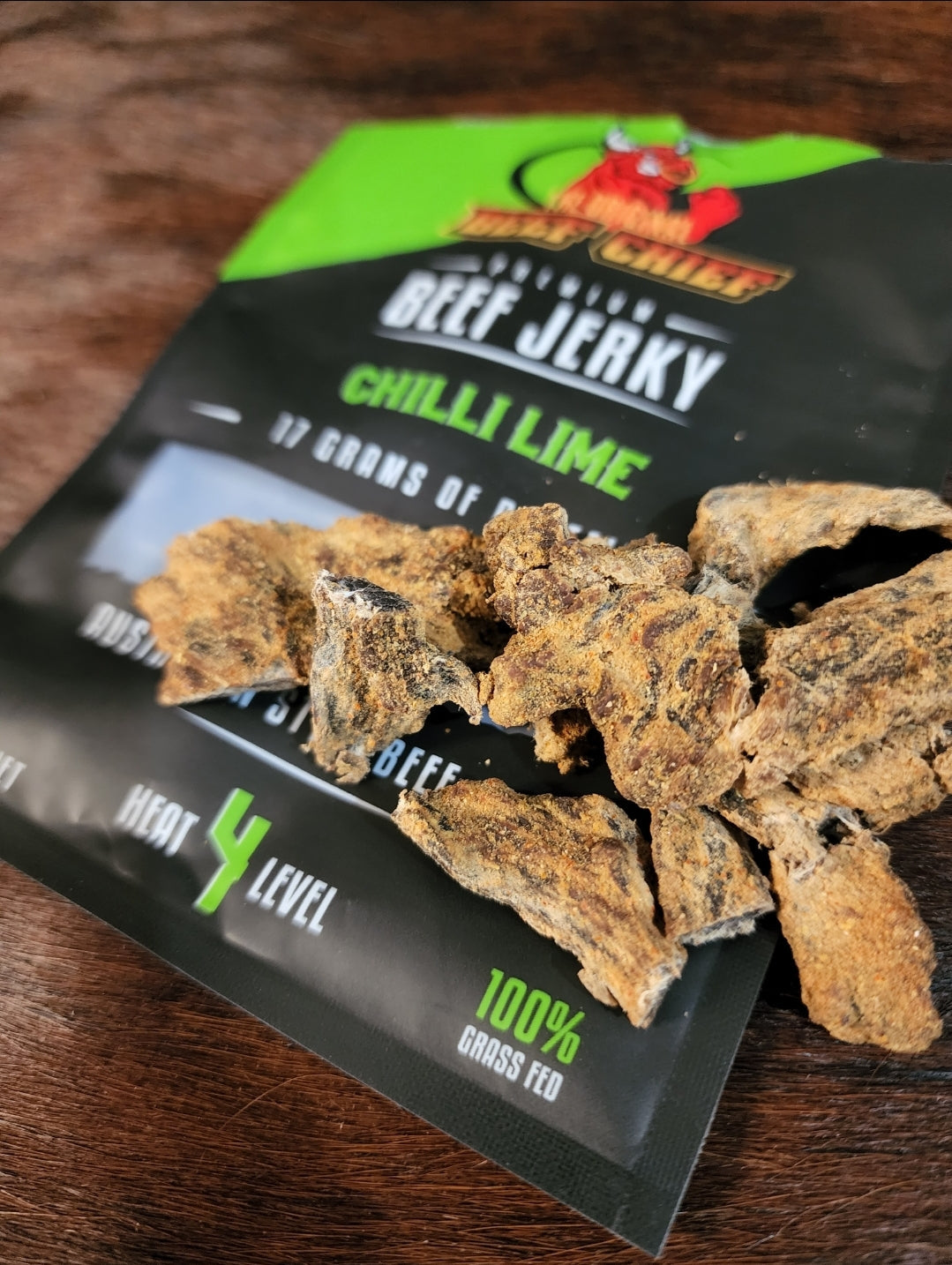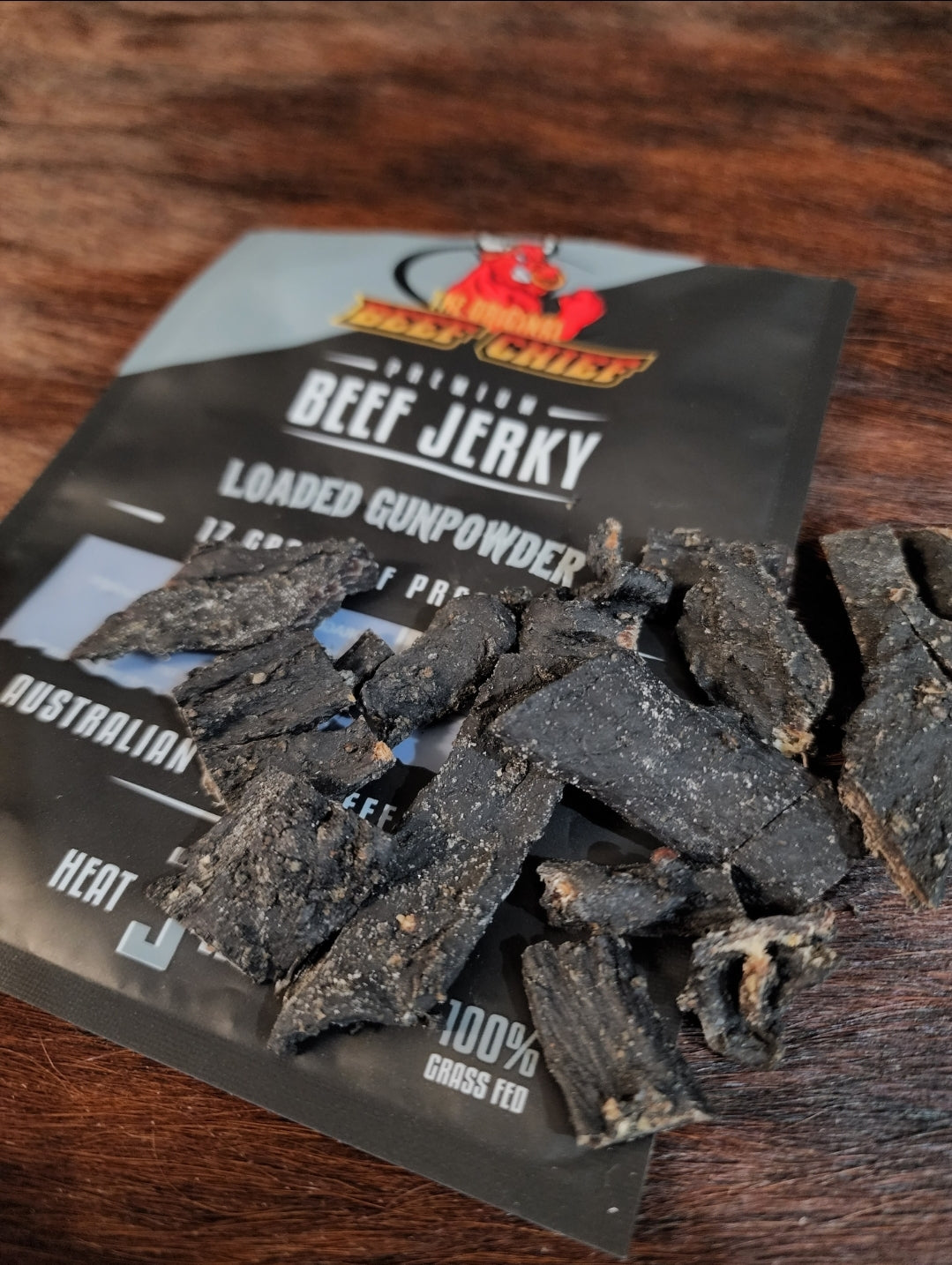The Best Chillies to Use for Beef Jerky: A Flavour Guide
Author: Robert Hall
When it comes to making mouth-watering beef jerky, the right chilli can make or break a flavour. Whether you want a mild kick or an inferno of flavour, selecting the perfect chilli is key. Here at Original Beef Chief, we think we've perfected the art of blending spices to create jerky that’s not just a snack but an experience. So, let's dive into the best chilies to use for your chilli beef jerky and how they can have you chewing, sweating and smiling all at once.
Benefits of Using Chilli in Beef Jerky
Using chilli in beef jerky isn't just about adding heat—there are several benefits to incorporating this spicy ingredient into your jerky recipes.
1. Flavour Enhancement
Chillies add a depth of flavour that goes beyond mere spiciness. Depending on the type of chilli used, you can introduce smokiness, sweetness, fruitiness, or earthiness to your jerky. This complexity can make your jerky more interesting and enjoyable. I feel that chilli "opens up" the tastebuds and brings out more flavour too.
2. Preservation
The capsaicin in chilli peppers has antimicrobial properties, which can help preserve the jerky and extend its shelf life. This is useful in maintaining the quality of the jerky over time. Chilli paste is acidic, helping to lower the PH of the marinade and creating a hostile environment for bacteria.
3. Health Benefits
Chillies offer various health benefits, such as:
- Boosting Metabolism: Capsaicin, the compound that gives chillies their heat, has been shown to increase metabolic rate, helping with weight management.
- Pain Relief: Capsaicin can act as a natural pain reliever by depleting 'substance P', a neuropeptide associated with pain sensation.
- Rich in Nutrients: Chillies are packed with vitamins, especially vitamin C and vitamin A, which are essential for a healthy immune system and skin health.
4. Appetite Control
Spicy foods can help control appetite by promoting a sense of fullness. This can be particularly beneficial for those looking to manage their weight without sacrificing flavour. Diets get BORING.
5. Increased Endorphin Production
Eating spicy foods can trigger the release of endorphins, which are the body's natural painkillers and mood enhancers. This can make consuming spicy jerky a more pleasurable and even addictive experience.
6. Cultural and Culinary Appeal
Different types of chillies allow you to explore and embrace various culinary traditions and flavours. The smokey chipotle from Mexican cuisine or the fiery Thai bird's eye chilli, each type of chilli brings its own cultural essence to your jerky.
7. Enhanced Circulation
Capsaicin in chillies can improve blood circulation by promoting vasodilation, which can help with cardiovascular health. Improved circulation also aids in the distribution of nutrients and oxygen throughout the body.
What chilli's does Beef Chief Jerky use?
1. Carolina Reaper: The Extreme Heat
For those who love to chase the heat, the Carolina Reaper is your go-to chilli. Known for its extreme and building burn, this chilli will turn your jerky into a fiery adventure. A little goes a long way, so handle with care and enjoy the thrill. We use BULK in our Creeping Reaper Beef Jerky - we reckon it's an 8/10 for heat.
2. Bird's Eye: The Tiny Titans
Small but mighty, Bird's Eye chillies pack a serious punch with a hint of citrusy flavour. Perfect for those who love very spicy jerky that wakes up the taste buds with every chew. These chillies will give your jerky a fiery kick that you won't miss. Try our Chilli Lime Beef Jerky for a taste of these beautys!
3. Cayenne: The Fiery Classic
Cayenne peppers offer a fruity, earthy flavour with a substantial kick. They’re a staple in our Ragin’ Cajun Beef Jerky, providing that lip-tingling sensation without overwhelming the taste buds. Perfect for those who like their jerky with a bit more punch.
4. Hot Paprika: The Smokey Touch
Hot paprika adds a rich, smoky depth to your jerky with a moderate heat. It’s perfect for creating a well-rounded, flavourful jerky that’s not too hot but still gives a tickle. Think of it as the smoky undercurrent that elevates your jerky to gourmet status. This is one of 3 chillies we use in our Chargrilled Chilli BBQ Beef Jerky.
5. Chipotle: The Smokey Seduction
Chipotle is a smoked and dried Jalapeño and they offer a rich, smoky flavour with moderate heat. Chipotle's add complexity and depth to your beef, making it a favorited in our Chipotle Biltong. Each bite delivers a satisfying chew and a burst of Smokey goodness.
How does the Scoville heat scale measure the spiciness of different chillies, and how do the chillies used in Beef Chief's jerky rank on this scale?
The Scoville heat scale measures the spiciness of chilli peppers by quantifying the concentration of capsaicin, the bit that makes chillies hot. Here's how the chillies used in Beef Chief's jerky rank on the Scoville scale:
- Carolina Reaper: This chilli tops the scale with an average of 1.6 million Scoville Heat Units (SHU) and can go up to 2.2 million SHU, making it one of the hottest peppers in the world.
- Bird's Eye Chili: These small but mighty chillies range between 100,000 to 225,000 SHU, providing a significant kick.
- Cayenne Pepper: With a heat range of 30,000 to 50,000 SHU, cayenne adds a moderate but noticeable spice to jerky.
- Hot Paprika: Typically ranging from 250 to 1,000 SHU, hot paprika provides a mild heat with a smokey flavour.
- Chipotle: These smoked jalapeños have a heat range of 2,500 to 8,000 SHU, offering a moderate heat with a deep, smokey flavour.
Understanding the Scoville Scale
The Scoville scale is a measure of the spiciness or heat of chili peppers and other spicy foods. It quantifies the amount of capsaicin, the chemical compound responsible for the sensation of heat, in a given chili pepper. Here’s how it works:
Origins and Method
The scale was developed by American pharmacist Wilbur Scoville in 1912. The original method, known as the "Scoville Organoleptic Test", involved dissolving a dried pepper in alcohol to extract the capsaicin, and then diluting the solution with sugar water. The solution would be tasted by a panel of five trained testers. The degree of dilution required to no longer detect heat determined the pepper’s Scoville Heat Units (SHU).
For example:
- If a chili pepper has a Scoville rating of 1,000 SHU, it means the extract needs to be diluted 1,000 times before the heat is no longer detectable.
Modern Techniques
Today, high-performance liquid chromatography (HPLC) is used to measure the concentration of capsaicinoids directly. This method provides a more accurate and consistent measure of a pepper’s heat, although the results are still often reported in Scoville units for consistency.
Practical Implications
Understanding the Scoville scale helps in:
- Cooking and Recipe Development: Ensuring the right level of heat for desired flavor profiles.
- Health and Safety: Handling extremely hot peppers like the Carolina Reaper requires caution to avoid skin irritation and other reactions.
- Consumer Awareness: Knowing the heat level helps consumers choose products that match their tolerance and preference.
The Scoville scale is an essential tool for anyone dealing with chili peppers, whether for culinary purposes or product development. It provides a standardized measure of heat, making it easier to balance flavors and ensure safety.
For further reading on the Scoville scale, you can check out resources like Britannica and Scoville Scale websites.
What are the different methods of incorporating chillies into beef jerky during the marination and drying process, and how do they affect the final flavour?
When making a chilli beef jerky recipe, incorporating chillies into beef jerky can be done in several ways, each affecting the final flavour profile:
- Powdered Form: Using chilli powders, such as cayenne or hot paprika, evenly distributes the heat and integrates well into the marinade. This method ensures a consistent spice level throughout the jerky.
- Whole Chillies or Chilli Flakes: Adding whole chillies or flakes, such as Bird's Eye or Carolina Reaper, can create pockets of intense heat and add a more varied texture and visual appeal to the jerky.
- Chilli Paste or Sauce: Store bought or homemade chilli pastes can add both heat and moisture to the jerky, infusing it with a rich, complex flavour. The smokiness of chipotle paste, for example, enhances the depth of the meats flavours.
- Infused Oils: Marinating the beef in oils infused with chillies can impart a consistent heat and allow the meat to absorb the flavours more thoroughly during the drying process.
"It's incredible... If I were to give Loaed Gunpowder beef jerky a flavor rating, it would be off the chart. It's that good. It's my new favorite beef jerky" - Johnny Scoville
For the hot heads!

Chilli Lime Beef Jerky

Creeping Reaper Beef Jerky

Spicy Beef Jerky Variety Pack

Loaded Gunpowder Beef Jerky
What are some common mistakes to avoid when using extremely hot chillies like Carolina Reaper in beef jerky, and how can these be mitigated to ensure a palatable product?
Using extremely hot chillies like the Carolina Reaper can be challenging. I know, I've been through it all while making our superhots - Creeping Reaper and Screaming Reaper. One fun arvo while taking my gloves off after making a batch of Screaming Reaper (I wear 2 pairs when making these marinades, that's how intense it is), the glove slipped out of my fingertips and flicked a thick glob of Trinidad Scorpion mash into my face - right in my eye in fact. And no one was around.
To say I was stuffed is putting it lightly.
Here are some common mistakes and how to avoid them:
- Overuse of Hot Chilles: Using too much can make the jerky unbearably spicy. It's crucial to use these chillies sparingly and balance them with milder peppers or sweet ingredients to create a more palatable product - unless the result you want is fire and tears.
- Improper Handling: Handling hot chillies without gloves can lead to skin irritation. Always wear gloves and avoid touching your face when dealing with extremely hot peppers.
- Uneven Distribution: Ensuring even distribution of the chilli throughout the marinade is key to preventing some pieces from being too hot while others are mild. Mixing the marinade thoroughly and letting the meat sit for a sufficient time helps achieve this balance.
- Lack of Ventilation: When drying jerky with hot chillies, ensure proper ventilation to avoid overwhelming fumes. A well-ventilated area or a dedicated dehydrator with good airflow is essential.
For more detailed information on the benefits and handling of chillies in beef jerky, you can visit sources like Healthline and WebMD.
Creating the Perfect Blend
Here at Beef Chief, we know that the best jerky often comes with a little extra kick to create a balanced and exciting flavour profile.
We've won 1st so many times in Mr Chili Australia's competitions we've stopped entering!
Whether you're a fan of mild flavours or a heat aficionado, experimenting with these chillies can help you find the perfect combination for your beef jerky.
Want to try some of our flavour-packed jerky? Check out our full range, from the mild Smokey BBQ Beef Jerky to the blazing Chargrilled Chilli BBQ Beef Jerky and beyond. Happy jerky making!
Stay Spicy,
The Beef Chief Team


Leave a comment